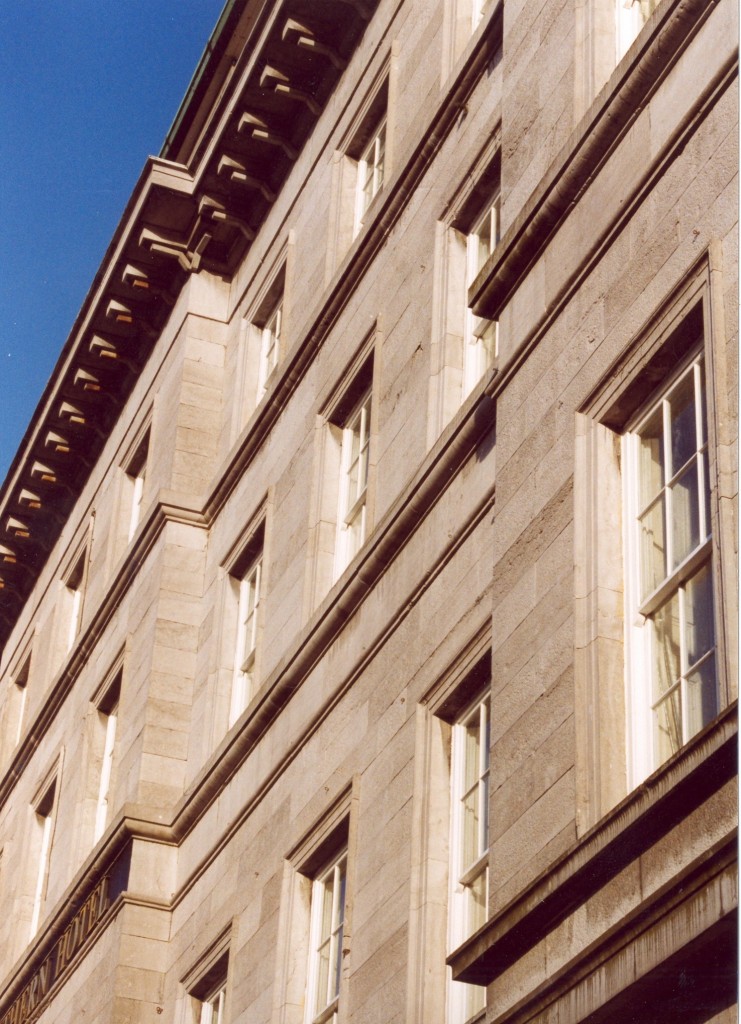GREAT SOUTHERN HOTEL, GALWAY

The ‘Meyrick’ Hotel, perhaps better known locally as the Great Southern, in Eyre Square (for a note on the naming see our next post) made some unfortunate local headlines recently. It’s a landmark hotel in the city centre dominating the western end of Eyre Square and is no stranger to controversy. Moore Group were involved in some restoration/redevelopment works in 2004 and we though it opportune to publish a brief history of this historic and significant local landmark.
The hotels history begins with the construction of the railway in the mid 1840’s. The Midland Great Western Railway of Ireland was incorporated on 21 July 1845, with the authority to construct a railway line from Dublin to Mullingar, Longford, Athlone and Galway. The railway was to follow the route of the Royal Canal, which the Railway had acquired.
It was five years before plans were being finalised for bringing the Railway to Galway. There was some difficulty in obtaining the necessary funds for the construction of the railway from Mullingar, but the continuing distress of the poor in the West and the possibility of alleviating that distress by providing work on the railway were taken into account and a £500,000 government loan was advanced in 1849. William Dargan was given the contract for the construction of the entire line and work began late in the same year.
Initially it was the intention to bring the Railway to Renmore, but lobbying by a number of people including ensured that the line crossed Lough Atalia to reach Eyre Square.
On Monday the 21st of July, 1851, the first train arrived in the station at Galway and on the first of August of the same year the line was opened for passenger traffic.
As the hotel was considered an integral part of the Railway, it was decided by the MGWR to divert some of the £500,000 loan they had received to construct the line into building the hotel, a decision not initially favoured by a number of the company’s shareholders, but considered by the company to be beneficial to the railway in the long term by increasing significantly the passenger traffic to Galway.
The size and grandeur of the hotel in Galway suggests a greater plan than simply the construction of the Railway. From the 1830s it became apparent that it was intended in many quarters that Galway would become a major transatlantic port. The MGWR engineer, George Willoughby Hemans, prepared a report on the feasibility of such an idea and the Railway was closely linked to these plans. An early guide to the Railway thought that it could not be doubted that the Galway Line would “become sooner or later the ordinary route for passengers and merchandise from Great Britain towards the North American Continent”. The plans were put into practise for a brief period from the late 1850s, when an Atlantic Royal Mail Steam Navigation Company was established. In early 1859 the company won a twelve-month contract for a regular seven-day run between Galway and St. John’s, Newfoundland, but the route lasted only three years.
The decision to build a hotel as part of the Galway terminus also reflected a serious need for high class accommodation in Galway. A report in the Tuam Herald in 1850 emphasised the need, stating that there were only two hotels in Galway and that both were so bad that travellers argued over which was the worst. The two hotels known to have existed at the time were the Clanricarde Arms, later Kilroy’s hotel and then the Imperial Hotel, founded in 1810 and Black’s Hotel, later Mack’s Hotel, founded around the same time. Both were located at the top of Eyre Square.
The Railway Hotel at Galway was the first of a number of hotels built by the Midland and Great Western Railway in the West, directed towards tourist traffic on the Clifden and Achill lines. Later in the 19th century hotels were built at Mallaranny (Mulrany), built by 1897 and already extended by 1900 and Recess, built incorporating an older hotel by 1896.
By January 1850 it was still the intention of the Railway Company to build the Terminus at Renmore, with a visit by the company engineers to finalise plans there in January of 1850. However, the decision to locate at Eyre Square appears to have been made by the end of the same year, when contracts for the construction were being awarded. In January of 1851 the order was given that construction begin on the Railway Station. At the end of the same month Mr. Mulvany, the architect, was asked for plans for the Hotel so that the works could commence. The building of the Hotel was awarded to William Dargan. The schedule for the construction of the hotel was extremely tight, with a condition attached which demanded completion of the works by the 1st of August 1852, on penalty of no payment.
By the 20th of December 1851, The Builder was able to report that the terminus was almost complete and that the stonework of the hotel was “in a forward state.” When the first train arrived in July of 1851 the terminus was completed with the exception of the roof, which had been destroyed earlier in the month in a severe gale. In February of 1852 it was clear that the building was behind schedule, but work appears to have increased in pace and the hotel was opened to the public on the 16th of August 1852 at a total cost of £24,960.1s.10d
A correspondent from the Railway Times in September of 1852 found the hotel already full to capacity.
The Architect of the Railway terminus and hotel in Galway was John Skipton Mulvany, with some additional input into the design of the terminus apparently coming from the company engineer George Willoughby Hemans. The hotel at Galway has been described as “unusually bland” for a Mulvany building. However, the design was appreciated in certain quarters and there was an unsuccessful plan to build a replica of the hotel in California, for which Mulvany prepared plans.
A note on Mulvany.
Mulvany (1813-1870) was a prolific and successful architect, who carried out commissions for many of the Railway companies as well as for a number of private clients, but was, however, all but forgotten during the second half of the nineteenth century. Some study of his work was carried out in the early 20th century but it was not until recently that a full survey of his career has been carried out. From the beginning of his time in private practice, Mulvany worked for the first Irish Railway company, the Dublin and Kingstown Railway, for whom he designed a hotel in 1836 and later a station at the same location. In 1841, Mulvany designed Blackrock station and Kingstown (Dún Laoghaire) station. In Dún Laoghaire, Mulvany enjoyed a virtual monopoly on buildings in the harbour, including both main boat clubs and a number of private dwellings. Kingstown Boat Club incorporated many of the trademarks of Mulvany’s buildings, such as a concealed roof, nautical railings, and a frieze of wreaths carved in relief. On the incorporation of the Midland and Great Western Railway in 1845, Mulvany was appointed the company architect, a position he held until 1850, after which he no longer worked full time but was engaged for a number of buildings by the Railway.The building for which Mulvany is perhaps best known is the 1850 Dublin Terminus for the Western Railway at Broadstone, a “Neo-Egyptian “ building incorporating the booking offices etc. parallel to the line of the railway and the passenger shed and the main block at the end of the line and at right angles to the railway, much the same as the layout at Galway.
This entry was posted on Tuesday, April 30th, 2013 at 1:43 pm. It is filed under Built Heritage and tagged with Eyre Square, Galway History, Meyrick Hotel.
You can follow any responses to this entry through the RSS 2.0 feed.





